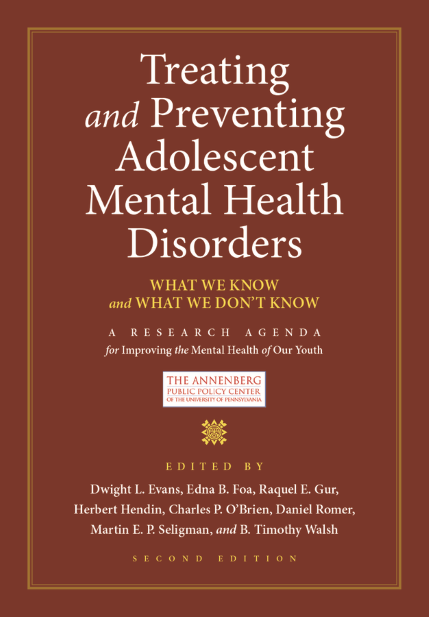Oxford University Press has published the second edition of “Treating and Preventing Adolescent Mental Health Disorders: What We Know and What We Don’t Know,” an extensive overview of the major mental health disorders that emerge during adolescence. The new edition provides a substantive update to the acclaimed original published in 2005, and includes new sections on gambling and internet addiction.
“This new edition incorporates the changes in DSM-5 diagnostic criteria and the many new findings since the first edition,” said co-editor Daniel Romer, Ph.D., research director of the Annenberg Public Policy Center of the University of Pennsylvania. “It also highlights the gaps in our understanding and the challenges that lie ahead in adequately promoting adolescent mental health.”

The volume presents the latest in treatment and prevention of major adolescent disorders, and updates the work of seven commissions under the Adolescent Mental Health Initiative convened by the Annenberg Public Policy Center and the Annenberg Foundation Trust at Sunnylands. Six of the groups pooled their expertise on such areas as adolescent anxiety disorders, schizophrenia, depression and bipolar disorder, eating disorders, substance and alcohol abuse, and suicide prevention, while the seventh commission examined positive youth development.
Experts in psychology and psychiatry thoroughly define each disorder, outline and assess available treatments, discuss prevention strategies, and suggest a research agenda based on what is and what isn’t currently known about these conditions.
“We hope this updated volume continues to fulfill our aim of informing practitioners and researchers of the successes achieved and the challenges that remain in ensuring the well-being and health of the nation’s youth,” said Kathleen Hall Jamieson, director of the Annenberg Public Policy Center of the University of Pennsylvania and program director of the Annenberg Foundation Trust at Sunnylands.
The second edition includes new chapters on gambling and excessive internet use. In the book’s Introduction, B. Timothy Walsh, M.D., said the two new areas “reflect an emerging interest in ‘behavioral addictions,’ patterns of behavior that bear strong similarities to substance use disorders (e.g., persistent and excessive time committed to the behaviors, leading to interference with other activities; reluctance to disclose the level of involvement to others, including parents).”

In the concluding chapter, Romer discusses successes and pressing issues for the future of adolescent mental and behavioral health, including progress from greater access to healthcare through the Affordable Care Act and the Mental Health Parity and Addiction Equity Act. But he notes that the challenges of gun violence and the pervasive effects of poverty remain, and the United States lacks a national strategy to enhance the development of youth.
The first edition of “Treating and Preventing Adolescent Mental Health Disorders” was acclaimed by reviewers and received the 2005 Award for Excellence in Clinical Medicine from the Division of Professional/Scholarly Publishing of the Association of American Publishers. A reviewer in The Journal of the American Medical Association wrote: “This volume is extraordinarily valuable in synthesizing a great deal of information based predominantly on such tightly controlled studies.”
And a reviewer in The New England Journal of Medicine said: “[This book] provides an excellent evidence-based review of each of the topics and manages to weave in clinically important findings that help to keep the information both practical and tangible to the clinician. The review of the data on how to define each disorder, how to treat it, and how to prevent it makes the book one that must be read by anyone involved in the routine care of adolescents. It is a clear and well-written book that should provide an evidence-based approach to the thoughtful care of adolescents, and it should be a ready reference on the shelf of any physician caring for adolescents.”
In addition to Romer, the book was edited by the seven commission chairs:
- Dwight L. Evans, M.D., Professor of Psychiatry, Perelman School of Medicine, University of Pennsylvania
- Edna B. Foa, Ph.D., Professor of Clinical Psychology in Psychiatry, Perelman School of Medicine, University of Pennsylvania
- Raquel E. Gur, M.D., Ph.D., Professor of Psychiatry, Neurology, and Radiology, Perelman School of Medicine, University of Pennsylvania
- Herbert Hendin, M.D., CEO and Medical Director, Suicide Prevention Initiatives
- Charles P. O’Brien, M.D., Ph.D., Professor of Psychiatry, Perelman School of Medicine, University of Pennsylvania
- Martin E. P. Seligman, Ph.D., Professor of Psychology, University of Pennsylvania
- Timothy Walsh, M.D., Professor of Pediatric Psychopharmacology, College of Physicians and Surgeons, Columbia University
Treating and Preventing Adolescent Mental Health Disorders (920 pages, $89.95) is also available as an eBook and will be available online free after one year.
To download this release click here.
The 2005 edition of Treating and Preventing was digested into a series of resource books for parents and young people on issues such as adolescent depression and bipolar disorder, eating disorders, anxiety disorders, schizophrenia, suicide, and substance abuse. Through our collaboration with Oxford University Press, we will be publishing updated editions of the four resource books for parents as well as a new book, “If Your Adolescent Has ADHD,” by Thomas J. Power, Ph.D., and Linda Wasmer Andrews, under the guidance of series editor Patrick E. Jamieson, Ph.D.
The previously published guides for parents and adolescents are available as free downloadable PDFs at APPC’s website under the Adolescent Mental Health Initiative.

